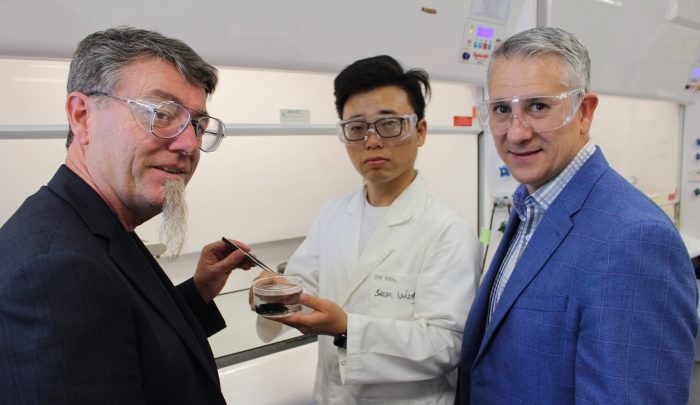News
3D printing bone tissue
Jun 28 2022
It seems Rumpelstiltskin is alive and well at the ARC Centre of Excellence for Electromaterials Science (ACES), with our researchers taking graphene and spinning it into medical research gold.

The team from our University of Wollongong node in collaboration with researchers from the University of Texas at Dallas, have developed novel graphene fibres as a new electrical stimulation device that could replace the use of pharmaceuticals to treat a range of medical conditions.
While pharmaceutical drugs have revolutionised the treatment of a multitude of conditions, there are a number of limitations in terms of side effects and focused delivery. The emerging field of electroceuticals allows for the localised targeting of electrical stimulation to the neural circuits of specific tissues and organs to develop, improve and regenerate performance.
Up until recently, implatable electrodes for electroceuticals were created using standard materials, which resulted in some compatibility issues with soft tissue, therefore limiting the effectiveness of the electrical communication with the nerve.
To combat this challenge, the ACES team used the traditional wet spinning fabrication method to manufacture a new style of fibre based on graphene to develop the ‘sutrode’, which combines the electrical properties of an electrode with the mechanical properties of a suture.
These sutrodes have demonstrated significantly improved electrochemical activity within nerves, and are stiff enough to penetrate soft nerve tissue, yet flexible enough to accommodate for micro-movements once implanted.
ACES Director Prof Gordon Wallace said the ACES team has long held a vision that the extraordinary properties of graphene could be used to enable better electrical communication within nerves, and the sutrode has shown that this is possible.
“The sutrode is truly ground-breaking for the field of electroceuticals, and offers opportunities and results that may not be possible within pharmaceutical treatments,” Gordon said.
“Greater spatial control is the key in successful electroceuticals to effectively stimulate specific nerves to treat medical conditions, and the sutrode has demonstrated unprecedented sensitivity in recording signals from nerves and unprecedented spatial control over the electrical stimulation of nerves.”
Prof Mario Romero-Ortega from the University of Texas at Dallas, said the collaboration with ACES had brought about state-of-the-art advances in implantable electromaterials for medical bionics and electroceuticals.
“Our sutrodes could be an ideal material for developing the next generation of neural stimulation and recording electrodes that provide the opportunity to treat a range of diseases without drugs, such as diabetes,” Mario said.
“The strength and flexibility of the sutrode allow us to tie the device around incredibly small nerve bundles that then record and detect neuronal activity, giving us more effective communication from these individual nerve areas than any current electroceutical methods to then determine specific treatments for specific conditions.”
The sutrodes will be produced at TRICEP, Australia’s newest 3D bioprinting initiative, located in North Wollongong. TRICEP is a 100 per cent owned initiative of the University of Wollongong, and works with research institutions to develop innovative technologies using 3D bioprinting and biomaterials.
This work, outlined in a paper titled “High performance graphene fiber based neural recording microelectrodes”, was recently accepted by the Journal of Advanced Materials.
You can listen to Professor Wallace and Professor Romero-Ortega’s further explanation of this ground-breaking work in a recent interview with ABC Illawarra’s Nick Rheinberger.













